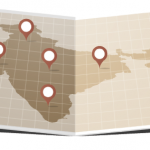Not only are serious accidents epidemic, but the ability of hospitals—especially those in rural areas—to handle the immediate consequences of complex fractures and other traumatic injuries can be limited. Recognizing the extraordinary toll of road accidents, the UN Road Safety Collaboration developed a Global Plan for the Decade of Action for Road Safety 2011–2020. On April 15, 2016, the UN General Assembly adopted a resolution on “Improving Global Road Safety.”
One source of the problem is evident: The developing world has many bad roads. Indeed, 90% of the casualties occur in developing countries.
Construction materials can be poor and street lights negligible. Ruts and potholes are frequent, causing drivers to swerve, veer and zig-zag to avoid a broken axle.
In addition, roads in the developing world are subject to a phenomenon called heterogeneous traffic. This type of traffic, which is comparatively rare in the West, occurs when people and conveyances of varying size and speed share the same space and compete for right of way. This situation makes collisions, crashes and other mayhem an everyday event.
Any crash on the roads is bad, but the mismatch of size, speed and composition (flesh vs. steel) magnifies the damage. Morbidity and mortality are high, exceeding that of some deadly infectious diseases, and the hazard to bone and joint is far beyond that of inflammatory arthritis and even osteoarthritis. A life walking with a stick or a crutch to support a shriveled leg is, unfortunately, very common among victims who have suffered fractures.
Despite the carnage of the roads, traffic in the developing world is often no more than a source of curiosity and amusement, even a good laugh. India is a case in point. The scene in the movie, The Best Exotic Marigold Hotel, in which Judi Dench, Maggie Smith and other pensioners ride a bus to their hotel is hilarious, but the scenario is real, not the creation of the special effects department.
One YouTube video I found called itself “a very funny look at India traffic.” No doubt, most of the 9 million viewers of this clip logged on to laugh at the raging chaos shown on a smog-clouded street. As I have learned subsequently, very few of my colleagues in rheumatology or orthopedic surgery have ever even heard of heterogeneous traffic, and I doubt that many textbooks in these fields list heterogeneous traffic in the section on the etiology of disease. I did not fully appreciate it until I witnessed it first-hand on a recent trip to India.
